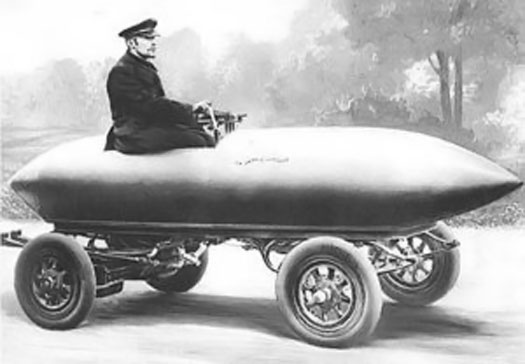
The future of the car has been electric for what? Five years now? Ten? The answer is 110 years, for it was back in 1899 that La Jamais Contente (The Never Satisfied) became the first vehicle to go over 100 km/h (62 mph) at Achères, near Paris.
Since then, as we produced hundreds of millions non-electric cars — and despoiled the biosphere in the process — all manner of non-petrol cars, including electric ones, have come and gone. Tesla in the the US and Norway's Think are just the latest in a long line of newcomers.
They, too, will fail to break the grip of the gas guzzler for one reason: they do not challenge the production system and business model of an incumbent global industry that is so mature that it can only make incremental changes as new pressures arise. Electric cars such as Tesla fall into this category: they are an incremental improvement, not a replacement for an ecocidal global industry.
This writer has long been sceptical that small private vehicles would have an important role to pay in a sustainable mobility mix. But Riversimple has made me pause for thought.
At a presentation in Leicester, UK, last month, where a deal has been struck with the City Council for 30 vehicles to be piloted there in 2012, we were told that the formal purpose of this new start-up is “to build and operate cars for independent use whilst systematically pursuing elimination of the environmental damage caused by personal transport.”
Not reduce but *eliminate* environmental damage? How could that be possible?
The company's founder, Hugo Spowers, explained that every aspect of the company's operation — not just its vehicle technology — is based on whole system design. It has evolved from a linear resource-consuming model, in which natural capital resources are not replenished, to a cyclical system in which waste streams provide all material inputs, and all loops are closed.
The car itself has five novel features: a composite body, four electric motors, no gearbox or transmission, regenerative braking, and power provided by hydrogen fuel cells. Its Network Electric Platform has been so designed that if there are breakthroughs in other power sources, these can easily be incorporated later on. The vehicle is decoupled from a single power platform or refuelling infrastructure.
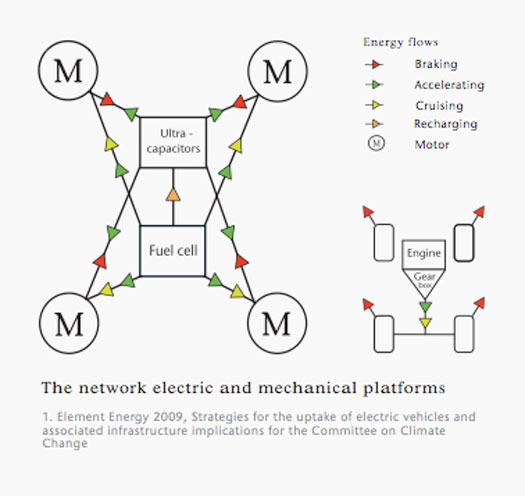

But Riversimple's technology is just the start. It's cars will not be sold outright. Customers will buy mobility as a service rather than a car as a product. There will be no maximum or minimum mileage allowance and critically, it is a fully bundled service covering all costs such as road tax, vehicle maintenance, insurance and fuel, with no surprises to the customer.
The way the system has been designed, it is in everyone's interest to keep cars on the road as long as possible. Riversimple will be the first car manufacturer for whom success will not mean persuading you to buy a new one every three years.
Customers will interact with Riversimple and its user community through a personalized digital interface accessed from the car, on their computer or via their mobile phone. They will be able to manage their account, request maintenance, ask questions, locate the nearest refuelling station and so on.
To ensure that energy and resource efficiency remain at the heart of everything the company does, lower environmental impact is financially rewarded.
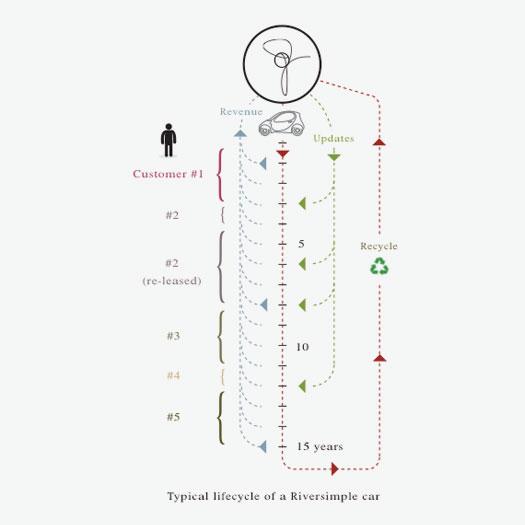
A sale of a service model is therefore pushed upstream into the supply chain. The supplier of the hydrogen fuel cell, for example, is likely to remain its owner. Manufacturer and supplier thereby have a shared interest in the longevity and reliability of the vehicle, and of the system as a whole.
Riversimple's production model, too, is distributed. Its carbon composite bodies allow profitable manufacturing with plants producing 3-5,000 units each year. This regional distribution of production will enable the delivery of improved service for regional markets at reduced cost. (The company is in early stage discussions with other regions across the world to roll out this strategy through joint venture partnerships for local manufacturing facilities.)

The next consideration is service. An urban car is effectively tethered to its home city, so the critical scale for establishing a commercial market is that of a city, rather than a nation. Riversimple's service infrastructure, too, is cellular — city by city.
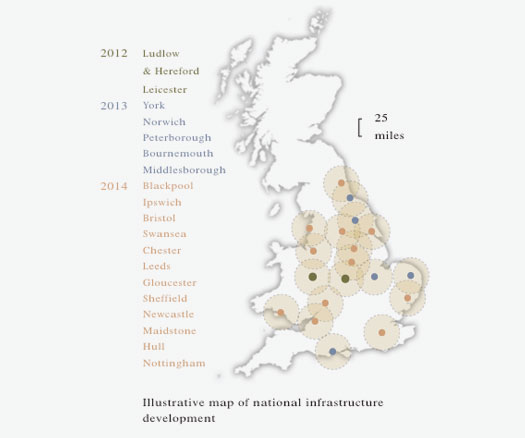
The surprises continue. Everything in RiverSimple is open source. The company is adopting an open intellectual property model, based on that used in open source software. The design of this and future vehicles will be shared, thereby allowing anyone to collaborate in the design and build of our cars under an open source licence.
Riversimple, as one producer among many, believes this will be a fast route to replacing the internal combustion engine.
The aim is to maximise design input from passionate experts at low cost. It is therefore also licensing its technology to the open-source foundation 40 Fires. Riversimple wants people to contribute to the design in the same way computer programmers help build Unix.
The company is owned by six "custodial bodies." Among these is Environment — on an equal footing with investors and commercial partners. Checks and balances are built into the system through the appointment of a Stewards body, who are responsible for auditing and monitoring the governance.
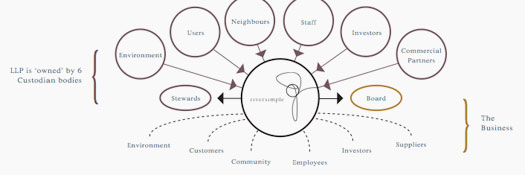
The structure and responsibilities of conventional corporations create a confrontational dynamic with most stakeholders. Therefore shared ownership is another key feature of the Riversimple system. Its ownership model is inspired by long-standing and successful businesses such as VISA International, John Lewis Partnership and Mondragon. All stakeholders have a formal role in the organisation, to all parties’ benefit.
Is RiverSimple another design-studio concept? Hardly: The family of Ernst Piëch, part of the dynasty who founded Porsche, is the current major investor.
Oh, you wanted to see the car? Here it is:
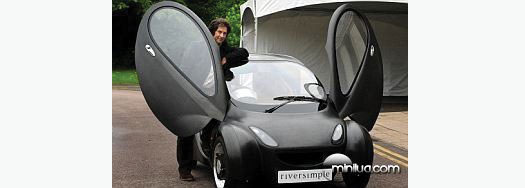


Comments [5]
I hope you don't mind that I linked to your article at my webpage, blakechastain.tumblr.com
Great article.
11.25.10
10:49
For the most part I like this concept. But there is a sad reality about hydrogen power that is very rarely pointed out in fuel cell vehicle articles I have read. It is a fact that I believe is equivalent to predicting a total failure of the fuel cell options.
That fact is that industrial quantities of hydrogen are produced through the steam reformation processing of natural gas. This process heats the NG to roughly 1000 degrees and combines it with lots of water (steam). It takes substantial energy to heat the NG and the steam for the process to work. The result is the desired hydrogen and vast quantities of CO2 as well as some Carbon Monoxide for good measure.
While it is certainly true that hydrogen CAN be obtained by electorlizing water the cost of this method is very high. It takes a great deal of electricity to do it.
Fuel cell vehicles cannot be called carbon neutral. At least not for as long as hydrogen is produced this way. All that a fuel cell vehicle does for the environment is relocate the emission of CO2 away from the vehicle and to the steam reformation processing plant.
Hydrogen is very difficult to hang on to, so when you factor in the losses of effeciency through the hydrogen storage and transportation systems it becomes true that it would have been simplier, cheaper and even less CO2 produced if we just drove small, high effeciency natural gas cars.
Take for example the fleet of hydrogen powered busses that were brought into service in Whistler for the recent Olympics. There is no hydrogen production facility in, or even near Whistler. So one has to ask where they get the hydrogen from. Does it get shipped from great distances onboard a diesel truck, slowly evaporating while in transit?
I won't even mention the quantity of platinum required to produce the fuel cells.
Please bear in mind that I wish hydrogen was a solution. Nothing would make me happier. I am an environmentalist I am not even all that worried about the costs. I want to save the world at any price. But hydrogen is not a solution. We need to have these facts included in the discussion about fuel cell vehicles. Failure to do so is little less than deceipt in my opinion.
12.02.10
11:41
Peter, I stand corrected about the negative features of hydrogen as a power source. I should have made more of an effort to mention those in my text. The irony is that this is the first positive article I have ever written about personal use vehicles as an element of sustainable mobility. For the record, though, I did not intend to deceive anyone.
12.07.10
10:26
In response to your point about the 'costs' of hydrogen, I would like to start by saying that I agree with much of what you say. There is little discussion of the well to tank CO2 of hydrogen and the auto industry players who maintain that it is the holy grail tend to turn a blind eye. However, I am also an environmentalist to the core and have spent many years trying to find answers. I completely understand why many people, for all the right reasons, reach negative conclusions about hydrogen, based necessarily on what the auto industry is doing, trying to adopt fuel cells incrementally; there are many highly inefficient hydrogen cars from which to choose! But the approach they are taking is not a fair reflection on the possibilities of hydrogen.
First, I would like to stress that Riversimple is not a hydrogen or a fuel cell company; the technology platform and the business model will accept any prime mover that produces electricity - battery, fuel cell or diesel genset. But we believe that, from an environmental perspective, hydrogen is the best solution for long range cars, but NOT for all applications. So I will try and make a few key points succinctly, that I think are also not aired publicly, that lead to our conclusion:
1. Both electricity and hydrogen are energy vectors that can be generated from any energy source. Both have CO2 consequences and some sources convert to electricity more efficiently, some to hydrogen more efficiently.
2. In the short term, both will come predominantly from carbon-emitting sources, but both can come from renewable sources, so in source terms an incremental transition is doable.
3. Hydrogen from natural gas is about 75% efficient.
4. If you design a car for a hydrogen fuel cell, rather than squeeze a fuel cell into a car and business model designed for a combustion engine, you can travel much further, in the same comfort and safety, than using any other energy source PER UNIT OF ENERGY - our car will do 240 miles per kg of hydrogen, equivalent to 300mpg in energy terms on petrol.
5. Using the figures from CONCAWE, the oil industry association, this gives a well to wheel figure of 31g of CO2 per km.
6. Electricity from natural gas is considered our cleanest form of fossil-derived electricity. In the UK this is 49% efficient, rather worse than electricity.
7. The lowest consumption figure I have seen published for a battery electric vehicle is the Think; using CONCAWE's figures, this gives 74g of CO2 per km.
I wholeheartedly support a more complex mix of fuels and powertrains in the future; hydrogen should never be as dominant as petrol, and fuel cells never as dominant as combustion engines. But on the basis above, my conclusion is that for vehicles with a reasonable range, hydrogen is the most efficient vector for cars, in CO2 terms as well as energy terms. I hope this makes as much sense to you as it does to me!
12.07.10
02:23
One of my main arguements about H2 is the enormous cost and complexity. If you take the example of the H2 busses built for the Whistler Olymnpics. Each one cost 2.4 Million dollars and to the best of my knowledge the H2 comes via diesel truck from Montreal. (This might be a rumour though). If we agree that H2 comes from NG then why not just make a NG bus and burn the NG that you have pointed out is the cleanest fuel we have. The same bus powered with NG would cost less than 1/3 the price of the H2 busses.
Then there is the weight question. I always wonder how much farther an electric car car could go with the same weight of the competing technology added using Lithium Batteries.
For example my car has about 1800 pounds of lead acid batteries in it. If I were to remove those lead ones and replace them with lithuim with exactly the same power rating then my vehicle could travel more than 3 times farther. Lithium is simply a far better battery that weighs a fraction of the lead powered equivalent.
A practical example of this is the Tesla. That car can go just as far and just as fast as a Porche 911. In fact if driven the same the Tesla will actually go farther.
I once heard a "street rumour" that if you pointed out that H2 comes from NG while working at Ballard Power then you would be introduced to the sidewalk and an employment seperation form. This kind of corporate behavior (if true) is appaling to me.
Promoting H2 power without presenting the underlying facts is just more of the same behaviour, namely public misdirection. We need to find rock solid solutions. Other than not traveling anymore I remain convinced that electric is the only way to go. But I also fully conceed that the social costs are enormous.
12.12.10
02:33